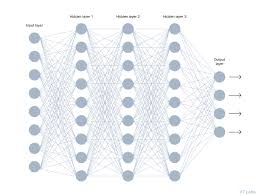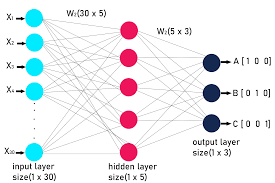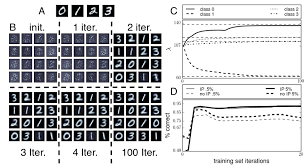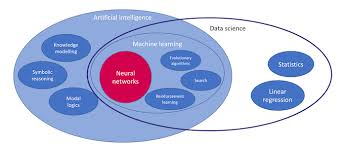Neural Network Classification: A Comprehensive Guide
Neural network classification is a powerful technique used in machine learning to categorize data into different classes or groups based on patterns and features. This method is widely used in various applications, such as image recognition, natural language processing, and sentiment analysis.
At the core of neural network classification is the neural network model, which is inspired by the structure and function of the human brain. The model consists of interconnected nodes, or neurons, organized in layers. Each neuron processes input data and applies a mathematical operation to produce an output signal.
Training a neural network for classification involves feeding it with labeled data, where each data point is associated with a specific class or category. The network learns to recognize patterns and features in the data through a process called backpropagation, where errors are minimized by adjusting the weights of connections between neurons.
One popular type of neural network used for classification tasks is the convolutional neural network (CNN), which is particularly effective for image recognition tasks. CNNs use convolutional layers to extract features from input images and pooling layers to reduce spatial dimensions while preserving important information.
Another common type of neural network for classification is the recurrent neural network (RNN), which is well-suited for sequential data processing tasks, such as natural language processing. RNNs have connections that form loops, allowing them to maintain memory of past inputs and make predictions based on context.
Overall, neural network classification offers a versatile and efficient approach to categorizing complex data sets. By leveraging the power of artificial intelligence and deep learning, this technique continues to drive advancements in various fields and pave the way for new possibilities in machine intelligence.
Eight Advantages of Neural Network Classification: From Complexity Handling to Scalable Real-Time Applications
- Highly effective in categorizing complex data sets
- Versatile application in various fields like image recognition and natural language processing
- Ability to learn and adapt to new patterns and features over time
- Can handle large amounts of data efficiently
- Provides accurate predictions and classifications with proper training
- Allows for parallel processing, speeding up computations for real-time applications
- Capable of handling non-linear relationships between input variables
- Scalable and can be applied to both small-scale and large-scale classification tasks
Five Drawbacks of Neural Network Classification: Data Demands, Overfitting Risks, Opacity, Computational Costs, and Inherent Biases
- 1. Requires large amounts of labeled training data to achieve high accuracy.
- 2. Prone to overfitting, where the model performs well on training data but fails to generalize to new, unseen data.
- 3. Complex neural network architectures can be difficult to interpret and explain, leading to challenges in understanding model decisions.
- 4. Training neural networks for classification tasks can be computationally intensive and time-consuming, especially for deep networks with many layers.
- 5. Neural network classification models may suffer from bias and discrimination if the training data is not diverse and representative of the target population.
Highly effective in categorizing complex data sets
Neural network classification stands out as a highly effective method for categorizing complex data sets with precision and accuracy. By leveraging the sophisticated interconnected structure of neural networks, this approach excels in identifying intricate patterns and features within the data that may be challenging for traditional algorithms to discern. The ability of neural networks to learn from labeled data and adjust their connections through training enables them to efficiently categorize diverse and intricate information, making them a valuable tool in various fields where sophisticated data classification is essential.
Versatile application in various fields like image recognition and natural language processing
Neural network classification offers a significant advantage in its versatile application across a wide range of fields, including image recognition and natural language processing. In image recognition, neural networks can effectively analyze visual data to identify objects, patterns, and features with remarkable accuracy. Similarly, in natural language processing, neural networks excel at understanding and interpreting human language, enabling tasks such as sentiment analysis, speech recognition, and machine translation. The adaptability of neural network classification to diverse domains underscores its importance as a powerful tool for solving complex problems and driving innovation in artificial intelligence.
Ability to learn and adapt to new patterns and features over time
Neural network classification stands out for its remarkable ability to learn and adapt to new patterns and features over time. This dynamic capability allows neural networks to continuously improve their performance as they are exposed to more data, enabling them to recognize subtle nuances and evolving trends in the input information. By adjusting their internal parameters through iterative training processes, neural networks can effectively adapt to changing conditions and refine their classification abilities, making them invaluable tools for tasks that require flexibility and responsiveness to novel patterns in complex datasets.
Can handle large amounts of data efficiently
Neural network classification stands out for its ability to efficiently handle large volumes of data. By leveraging parallel processing and distributed computing capabilities, neural networks can effectively process vast amounts of information in a relatively short amount of time. This scalability enables neural networks to tackle complex datasets with ease, making them ideal for tasks that involve analyzing and categorizing extensive data sets, such as image recognition, natural language processing, and big data analytics. The efficiency in handling large amounts of data makes neural network classification a valuable tool for various applications across different industries.
Provides accurate predictions and classifications with proper training
Neural network classification stands out for its ability to deliver precise predictions and classifications when properly trained. Through the process of training on labeled data and adjusting weights based on errors, neural networks can learn intricate patterns and relationships within the data, leading to highly accurate results. This accuracy makes neural network classification a valuable tool in various fields where precision is crucial, such as medical diagnosis, fraud detection, and image recognition. With the right training and optimization, neural networks can consistently provide reliable predictions that help drive informed decision-making and enhance overall system performance.
Allows for parallel processing, speeding up computations for real-time applications
One of the significant advantages of neural network classification is its inherent ability to facilitate parallel processing. This computational architecture mirrors the human brain’s parallelism, where many neurons can perform tasks simultaneously. By leveraging modern multi-core processors and sophisticated GPU architectures, neural networks can process vast amounts of data concurrently, dramatically accelerating computation times. This speed is crucial for real-time applications such as autonomous vehicles, where split-second decisions based on rapid data analysis can be a matter of safety. Similarly, in financial markets or healthcare diagnostics, the ability to analyze and classify data in real time allows for more timely and effective decision-making.
Capable of handling non-linear relationships between input variables
Neural network classification stands out for its ability to effectively handle non-linear relationships between input variables. Unlike traditional linear models, neural networks can capture complex patterns and interactions within data that may not follow a straightforward linear trend. By employing multiple layers of interconnected neurons and utilizing activation functions, neural networks excel at learning and representing intricate non-linear relationships, making them a powerful tool for tasks where the underlying data structure is complex and dynamic. This capability allows neural networks to provide more accurate and robust predictions in scenarios where traditional methods may fall short, showcasing the versatility and adaptability of this advanced machine learning approach.
Scalable and can be applied to both small-scale and large-scale classification tasks
Neural network classification offers the significant advantage of scalability, making it a versatile tool that can be applied to both small-scale and large-scale classification tasks with ease. Whether dealing with a modest dataset or a massive collection of complex information, neural networks can adapt and efficiently process the data to categorize it into distinct classes or groups. This scalability ensures that neural network classification remains a valuable solution across various applications, accommodating diverse needs and providing reliable results regardless of the task’s size or complexity.
1. Requires large amounts of labeled training data to achieve high accuracy.
One significant drawback of neural network classification is its heavy reliance on large quantities of labeled training data to attain high levels of accuracy. The process of training a neural network requires feeding it with labeled examples to learn patterns and features, which can be a labor-intensive and time-consuming task. Acquiring, preparing, and annotating sufficient amounts of data for training can be challenging and costly, especially for niche or specialized domains where labeled data may be scarce. This limitation can hinder the scalability and practicality of neural network classification systems in real-world applications that demand high levels of accuracy but lack access to extensive labeled datasets.
2. Prone to overfitting, where the model performs well on training data but fails to generalize to new, unseen data.
One significant drawback of neural network classification is its susceptibility to overfitting, a phenomenon where the model excels in accurately predicting outcomes based on the training data but struggles to generalize its performance to new, unseen data. This issue arises when the model learns noise or irrelevant patterns from the training data, leading to overly complex representations that do not reflect the underlying relationships in the dataset. As a result, the neural network may exhibit high accuracy during training but perform poorly when presented with real-world data, compromising its reliability and effectiveness in practical applications.
3. Complex neural network architectures can be difficult to interpret and explain, leading to challenges in understanding model decisions.
Complex neural network architectures can pose a significant challenge in terms of interpretability and explainability, which can hinder the understanding of model decisions. As neural networks become more intricate and layered to handle complex tasks, such as image recognition or natural language processing, the inner workings of these models can become opaque and difficult to decipher. This lack of transparency can raise concerns about the reliability and trustworthiness of the model outputs, making it crucial for researchers and developers to find ways to enhance the interpretability of neural network architectures for better decision-making and accountability.
4. Training neural networks for classification tasks can be computationally intensive and time-consuming, especially for deep networks with many layers.
Training neural networks for classification tasks can be a significant challenge due to the computational intensity and time-consuming nature of the process, particularly when dealing with deep networks that consist of numerous layers. The complexity of deep neural networks requires substantial computational resources to process and optimize the vast number of parameters involved in the model. As a result, training deep networks for classification tasks often demands high-performance hardware and extended periods of time to achieve optimal results. This con highlights the resource-intensive nature of training neural networks for classification and underscores the importance of efficient algorithms and hardware infrastructure in overcoming these computational hurdles.
5. Neural network classification models may suffer from bias and discrimination if the training data is not diverse and representative of the target population.
Neural network classification models may encounter a significant drawback related to bias and discrimination when the training data lacks diversity and fails to accurately represent the target population. In such cases, the model may inadvertently learn and reinforce existing biases present in the data, leading to unfair or discriminatory outcomes in its classifications. This issue highlights the critical importance of ensuring that training datasets are comprehensive, inclusive, and reflective of the diverse perspectives and characteristics of the populations they aim to serve, in order to mitigate bias and promote fairness in neural network classification applications.




